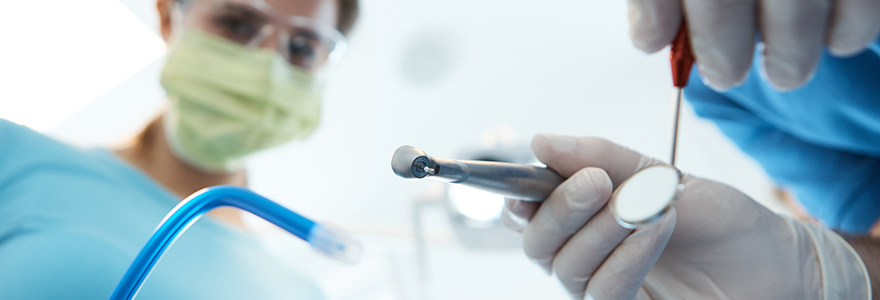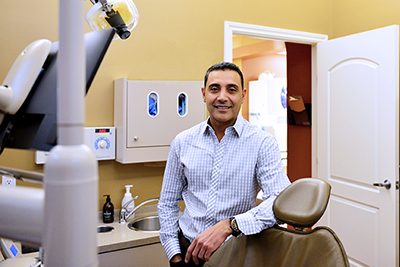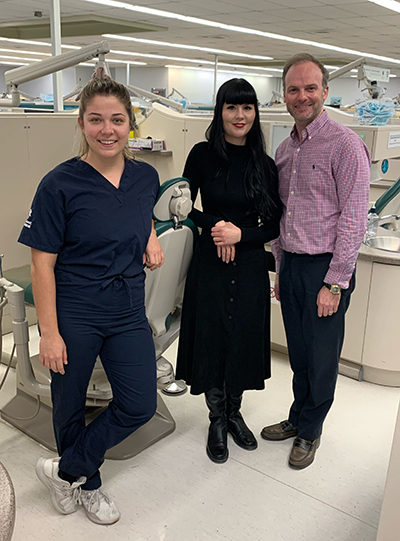Are you afraid of the dentist?

By Emily Leighton, MA’13
From a fish tank in Sydney, Australia, we get a front row seat to several dental chair horrors playing out in Pixar’s Finding Nemo. The popular animated movie includes an accidental tooth extraction, a painful root canal and plenty of dramatic screams.
Dr. P. Sherman of 42 Wallaby Way joins a familiar cast of dentists in pop culture and film. From Little Shop of Horrors to Horrible Bosses, the dental profession is often depicted in a negative light on the big screen.
Although fictional, these portrayals feed our collective dental anxiety. Studies have shown anywhere from 48 to 60 per cent of people experience a form of dental anxiety or extreme fear.
“No one is born innately afraid of the dentist,” said Dr. Shawn Steele, BA’01, DDS’05, JD’13, Assistant Professor. “For a lot of people it’s a past bad experience or it’s modelled behaviour from someone close to them.”
In 2020, there are many strategies dentists use to manage anxiety, from breathing and meditation exercises to pharmacological interventions. A growing number of dentists offer sedation and sleep dentistry for the most fearful patients.
Sedation uses a variety of medications to bring about a conscious but semi-aware state, including oral sedatives or nitrous oxide, more commonly known as laughing gas. A more extreme option is general anesthesia, or sleep dentistry, which renders patients completely unconscious.
In Ontario, sedation and anesthesia practices are regulated by the Royal College of Dental Surgeons of Ontario (RCDSO). The Standard of Practice on the Use of Sedation and General Anesthesia in Dental Practice sets out training and administration requirements.  Dr. Anand Soni, DDS’98, started incorporating sedation and sleep dentistry into his London, Ontario practice about 10 years ago to fill what he describes as a “gap in care.” He noticed there was a segment of the population that had dental insurance or could afford care, but didn’t seek treatment out of fear. “I was seeing people come in for emergency situations, having avoided the dentist for years,” he said.
Dr. Anand Soni, DDS’98, started incorporating sedation and sleep dentistry into his London, Ontario practice about 10 years ago to fill what he describes as a “gap in care.” He noticed there was a segment of the population that had dental insurance or could afford care, but didn’t seek treatment out of fear. “I was seeing people come in for emergency situations, having avoided the dentist for years,” he said.
When a patient requests sedation or general anesthesia, Dr. Soni and his team first determine what treatment is needed, working with the patient to finalize a treatment plan. From there, they review and discuss sedation options, including the benefits and risks.
“The art of dentistry is extremely important,” explained Dr. Soni. “If patients feel listened to and they are empowered to voice their fears, things often improve without any need for sedation.”
As part of his General Practice Residency at Ohio State University, Dr. Soni completed training for IV sedation and Advanced Cardiac Life Support. However, at his private practice, he employs anesthesiologists to administer sedation or general anesthesia, while he focuses solely on the dental care. “These are complicated procedures and there’s always a lot going on,” he explained. “It’s much safer for the patient and the team.”
He acknowledges that sedation and sleep dentistry services are good for business, but says patient need drives the work. “Each situation is unique, and the patient is the driver of the decision-making process,” said Dr. Soni. “Our goal is to graduate people out of sedation. Every provider’s goal should be to ease a patient’s anxiety so that they don’t need sedation at all.”
Patient-centred care is key to addressing dental anxiety, providing care in a way that is responsive and comfortable for each individual. At Schulich Dentistry, this approach is incorporated into all aspects of the curriculum.
“We train students to fundamentally connect with their patients, to build relationships and trust,” said Dr. Steele, Director of the Dentistry Surgical Care Unit. “It’s important to have an ongoing dialogue, to understand the patient’s circumstances and context and to receive informed consent.” Dr. Steele also points to interprofessionalism, or team-based care, as an important consideration when managing fear and anxiety. He teaches the second-year Practice Administration course and in 2019, organized a new collaborative workshop for dentistry and dental hygiene students. The joint session included a lecture, case study and discussion.
Dr. Steele also points to interprofessionalism, or team-based care, as an important consideration when managing fear and anxiety. He teaches the second-year Practice Administration course and in 2019, organized a new collaborative workshop for dentistry and dental hygiene students. The joint session included a lecture, case study and discussion.
“When we practice dentistry, we do so as part of an interprofessional dental team,” said Dr. Steele. “But dental education can be quite siloed. This workshop is the first introduction to scope of practice and overlapping roles, really determining who is the best team member to deliver care in the safest and most efficient way.”
Managing dental anxiety in children also requires specific consideration and strategies. Simply adjusting language and vocabulary, for example, can help make the dental office a friendlier and more inviting space.
Through the School’s paediatric dentistry program, students learn ways to manage young patients. “In the curriculum, we introduce students to dental fear and anxiety and explore how to safely manage behaviour in the clinical setting,” said Dr. Liliani Vieira, Chair of Paediatrics. “Students have an opportunity to practice some of these behavioural strategies and techniques in the children’s clinic, as well as shadow and observe faculty members at their local practices.”
From a research perspective, Dr. Vieira is interested in better understanding fear and anxiety in paediatric patients. In a 2016 paper for BMC Oral Health, her research team showed that certain dental procedures increased the levels of salivary cortisol, a physiological marker of stress, in children. “Most paediatric patients experience some degree of dental fear and anxiety,” said Dr. Vieira. “Dentists should be aware that even simple procedures are related to stress.”
Dr. Vieira believes early prevention can help address the underlying issue. “When you introduce a child to the dentist early on, ideally within the first year of life, they start to become familiar with the environment, the sounds and the equipment,” she said. “It becomes a more pleasant, regular experience, not just reactionary treatment when something goes wrong.”
She also stresses the importance of referrals. “For general practitioners, it’s important to know when to refer the patient to a specialist, who will have more comprehensive training and can determine what type of sedation is best suited.”
While the creators of Finding Nemo played into our fears about visiting the dentist, dental professionals are working to change stereotypes by offering patient-centred, comprehensive care. With their efforts, perhaps we’ll see a movie about an approachable, competent and heroic dentist hit theatres someday soon.








